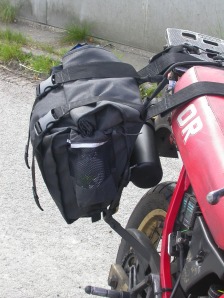Had to skip a week because of family stuff but back on the horse so to speak.
I’d got my RGS and RGA barrels measured for ovality. Laverda recommend no more than 0.05mm out of round – the RGA barrels passed but not so the RGS (not surprising as I’d run these with very low/no oil). The RGA barrels were honed but still have a slight mark at the top of the barrel which I’m told is okay – hmmm?
It would be easy to just dismiss the advice that it’s okay and get everything new but if it is good enough then if I get another 20,000 miles then it’ll be no bad thing. The engineering firm have also offered to see if they can match the Laverda piston rings with those of a car to save me money & gave me Laystall Engineering as a source of re-manufactured liners.
Along with the honed liners I also took delivery of two sets of second-hand RGS pistons. There’s enough of these around due to owners upgrading to high compression ‘Corsa’ pistons. Fair enough if that’s your bag but I never found a problem with the performance of a standard set of slugs.
So progress on the triple front and some also on the Atlas. The Atlas is still in Glasgow awaiting Keith Nairn to complete the RGS crankshaft rebuild and send this along with bike back to me. In anticipation of the bikes return I had to start work on the Atlas original motor. The mainshaft needs replacing but thinking that this engine has a good bottom end but needs a head with good valves I figured if I sorted the mainshaft I could just pop the head of the Glasgow on when it arrived. I duly set to dismantling the original motor.
Dismantling the motor wasn’t that complicated. The main hassle was that the pistons don’t go through the block attached to the con-rods so the crank is still attached to the top case. Other than this it all came apart easily enough.
I haven’t taken the head apart to check the valves but wonder if they are damaged after finding very worn oil ring spring in the right hand bore. Was this the cause of excessive oil in the inlet track? I also think that the balance weight on the primary side might be loose despite the nut and lock washer being in place. Rocking the balancer shaft created a knocking noise not unlike that in the Glasgow motor so I will check this before stripping that bike.
Finally to try and get back onto two wheels I have also started to see if I can recommission the VFR. Aside from the electrics which need sorting (bad earths etc) the oil cooler pipes had corroded to the point of leaking. I’d forgotten that while you can’t fault the Japanese engineering you have to remember that to make such great motorcycles as such a low price quality has to be compromised somewhere – welcome to bolts made of chocolate…On sheared bolt later and I proceeded with a liberal dose of penetrating oil and blow torch to loosen things up. Makes you respect the build quality of a Laverda even more…
Nick









